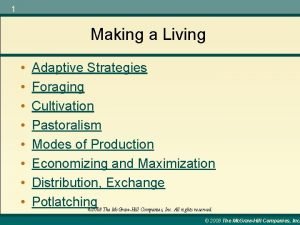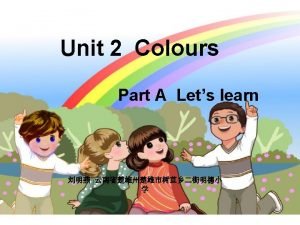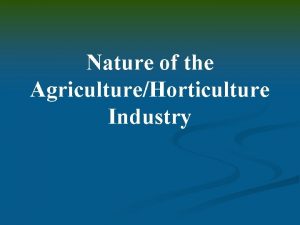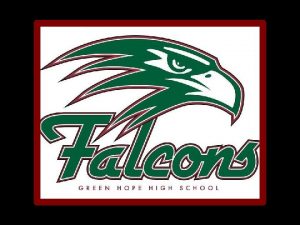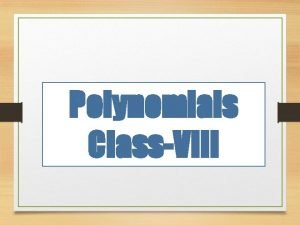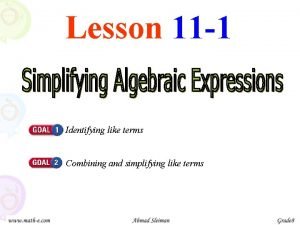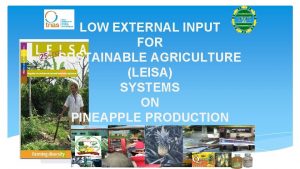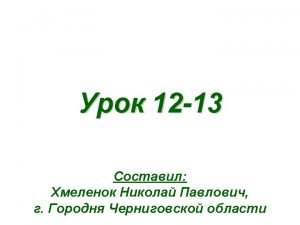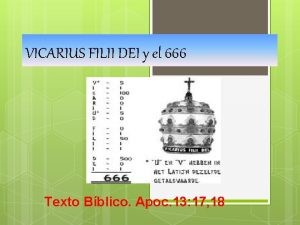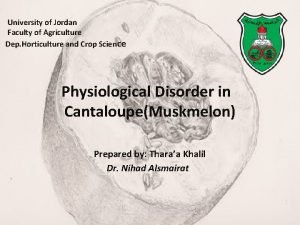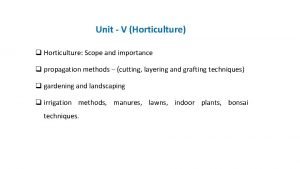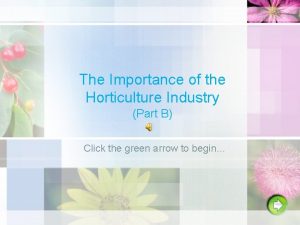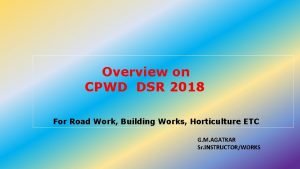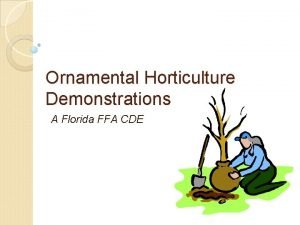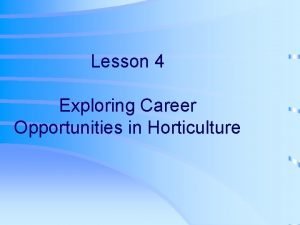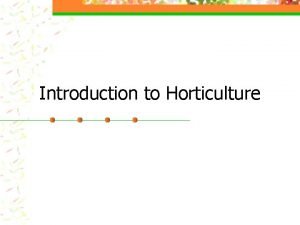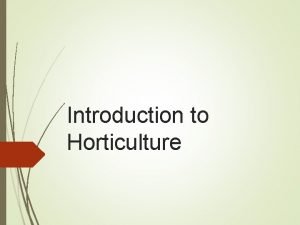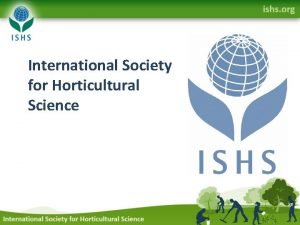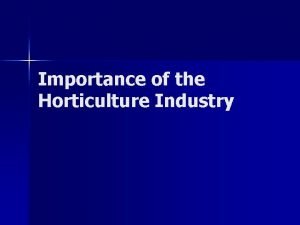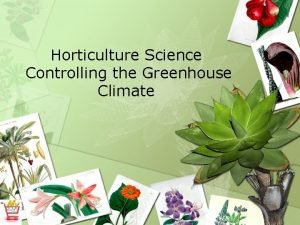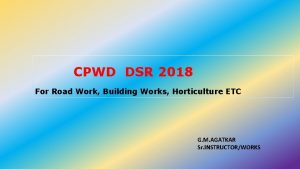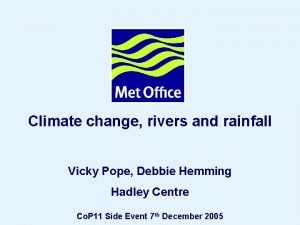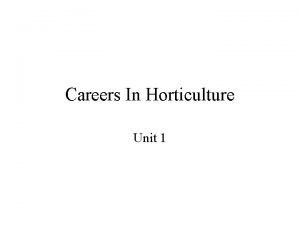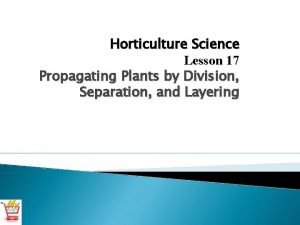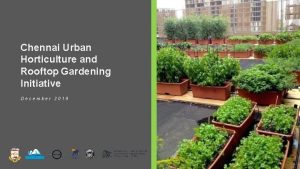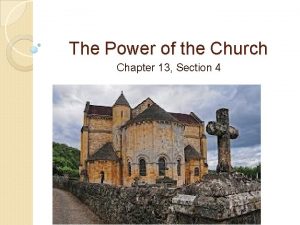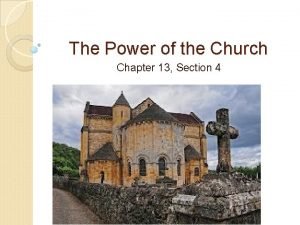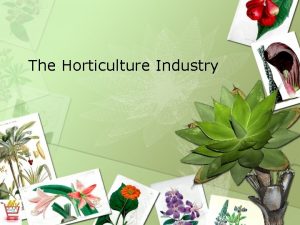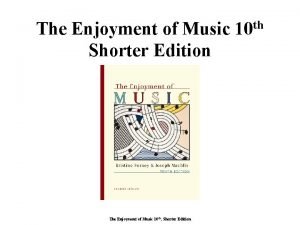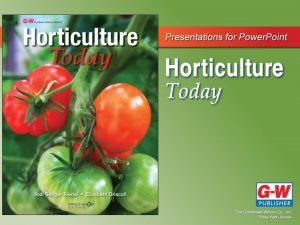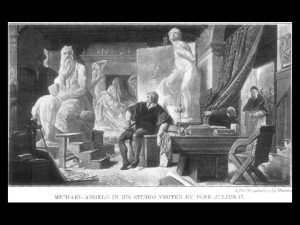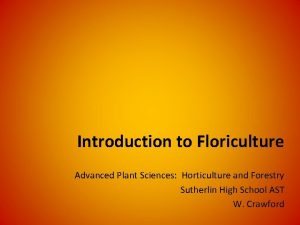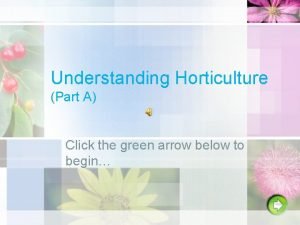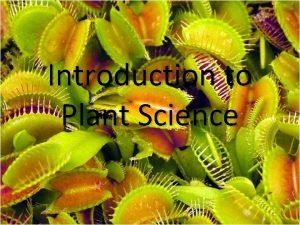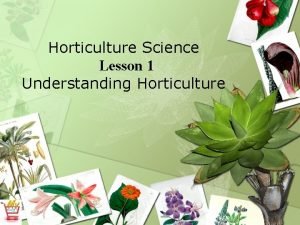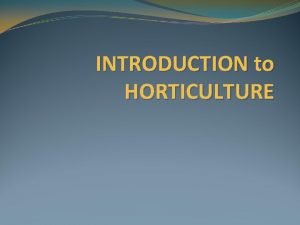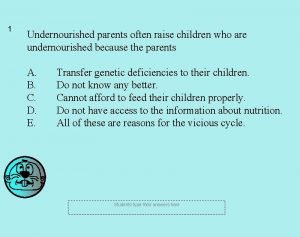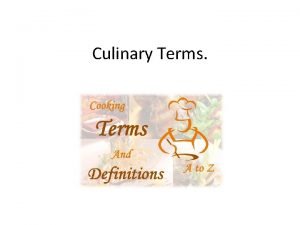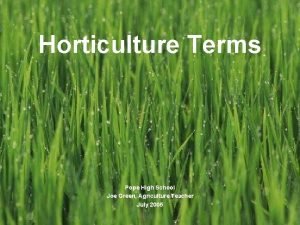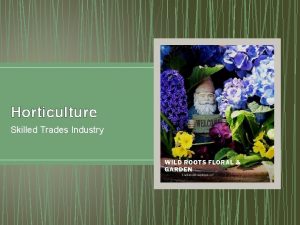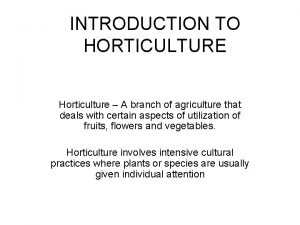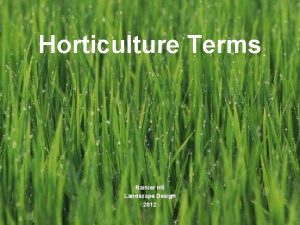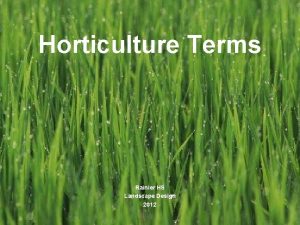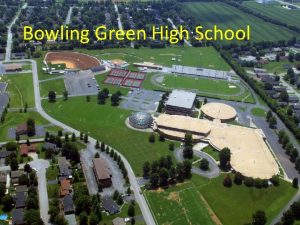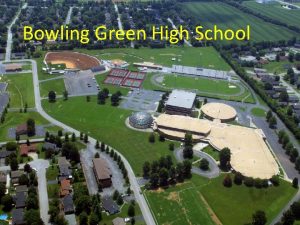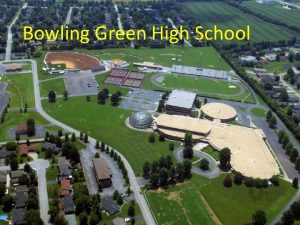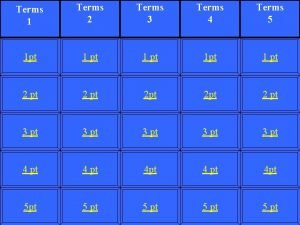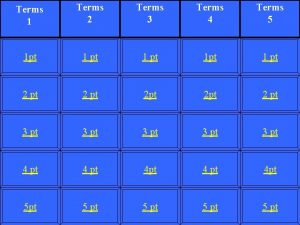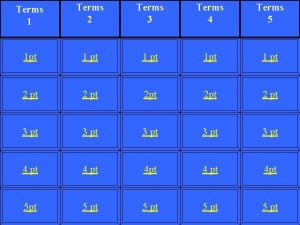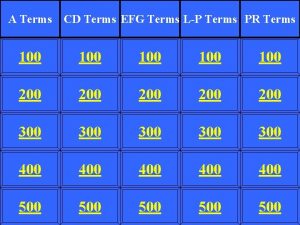Horticulture Terms Pope High School Joe Green Agriculture


















































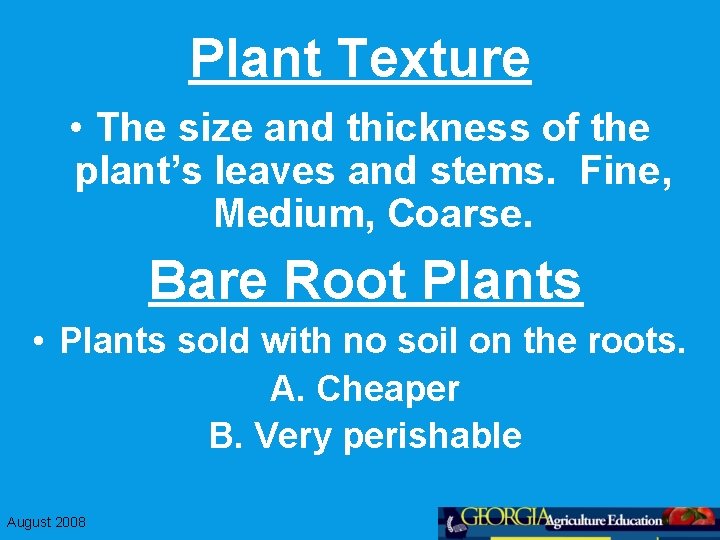
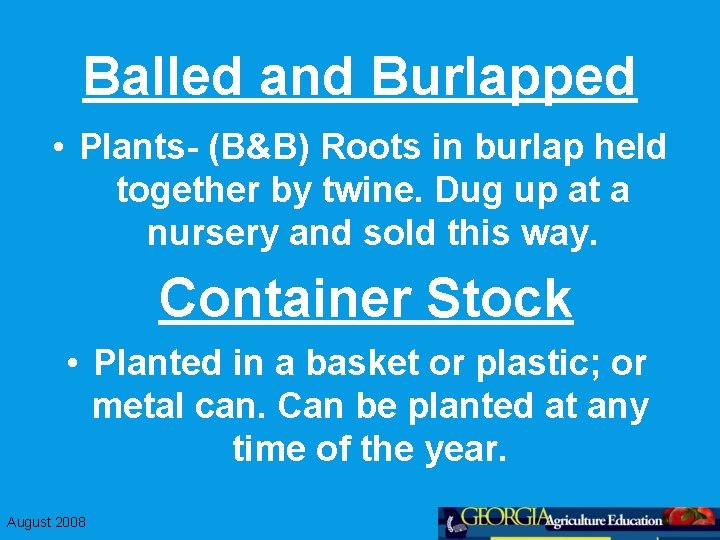
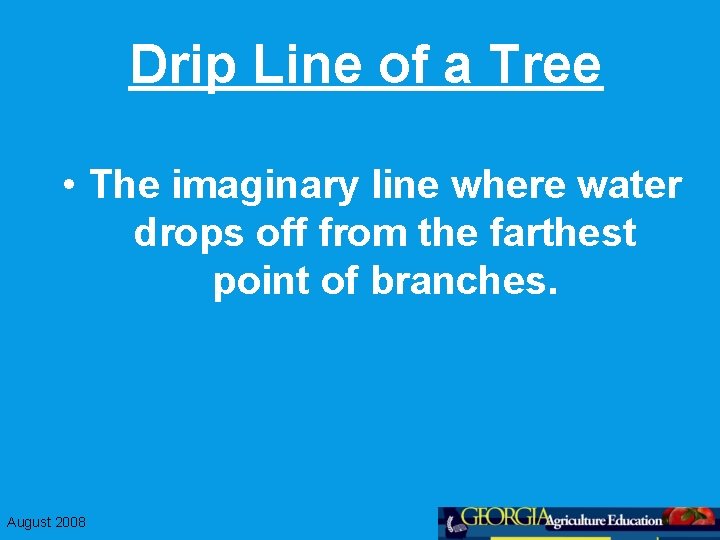
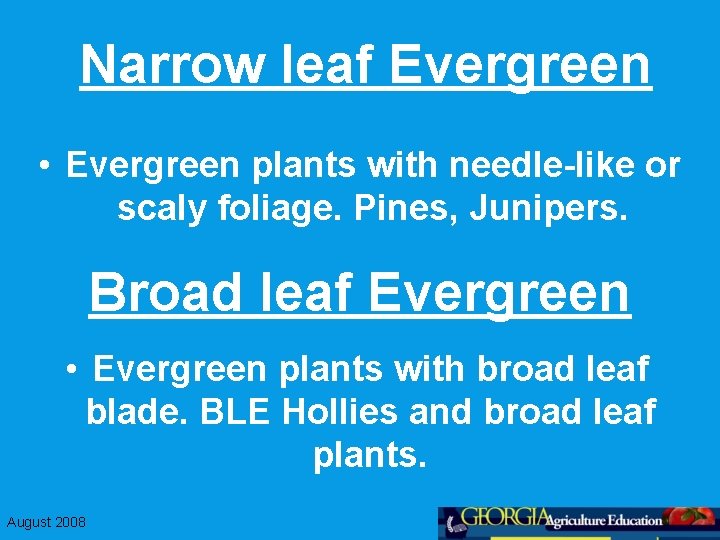
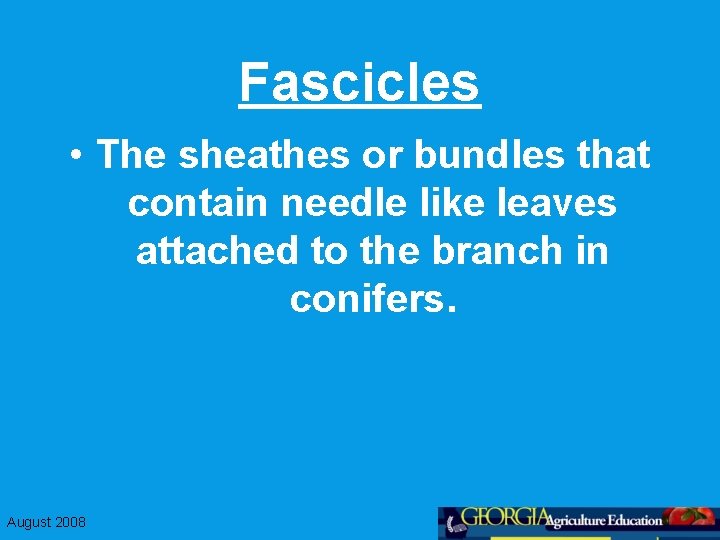
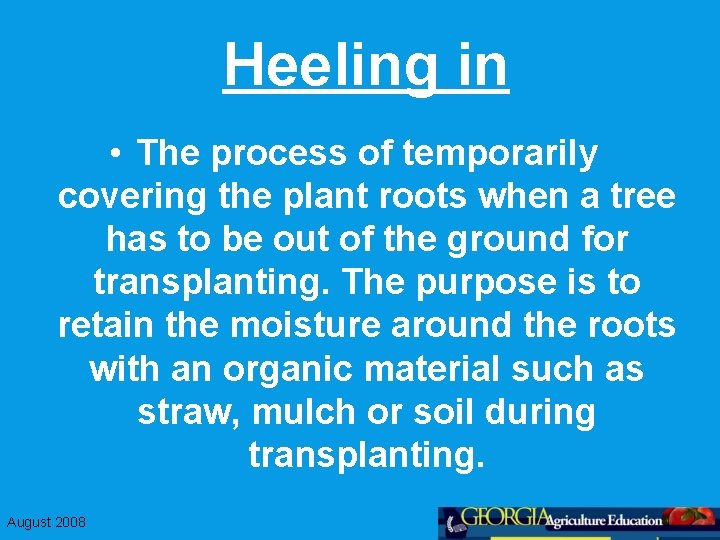
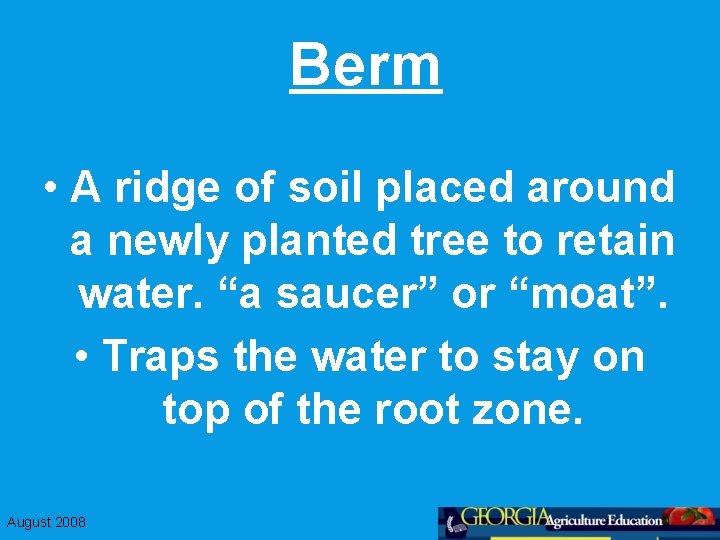
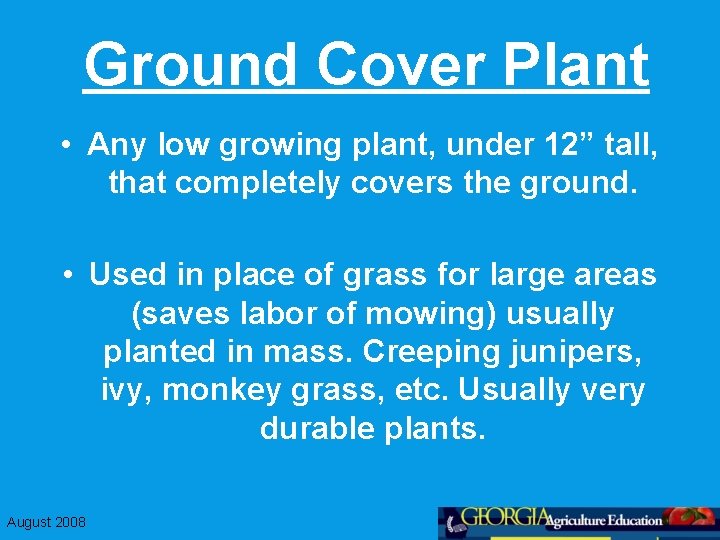
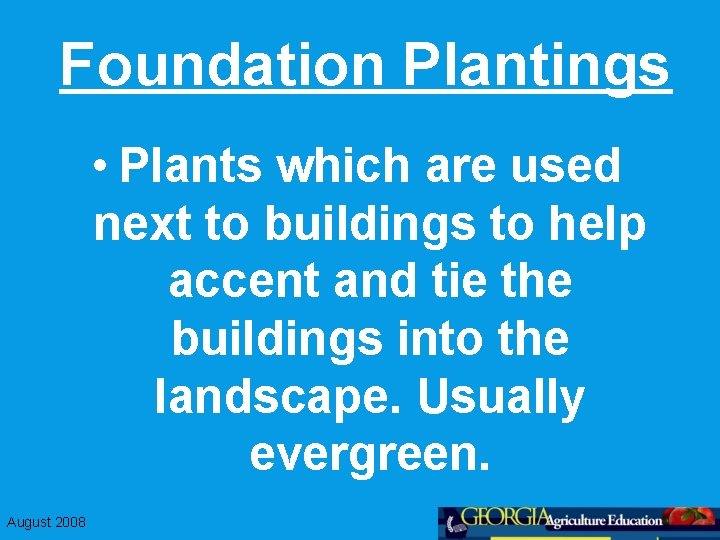
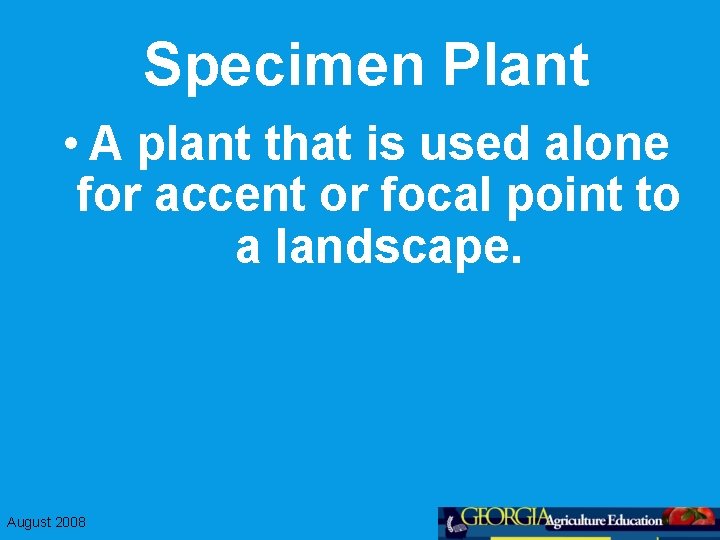
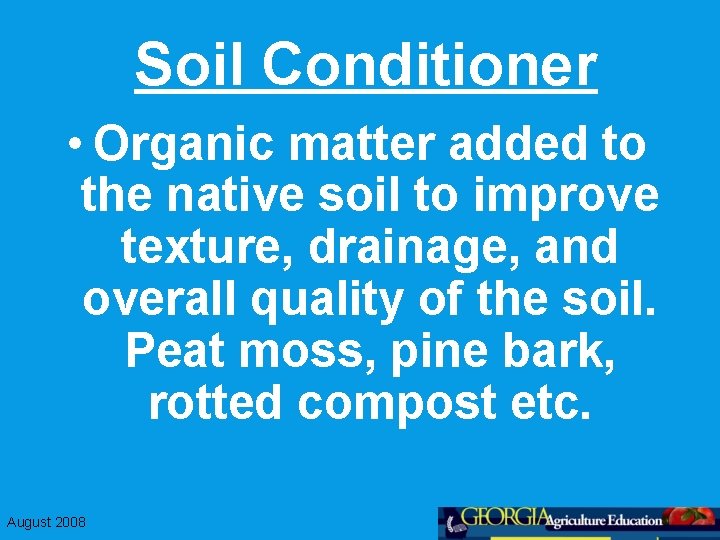
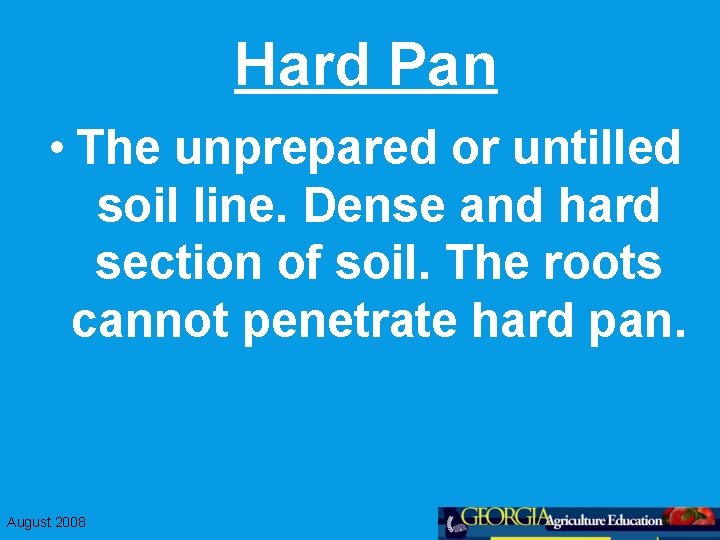
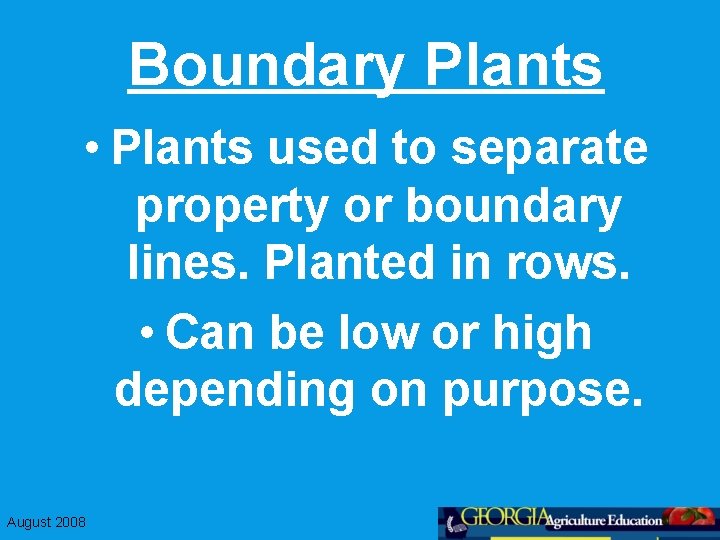
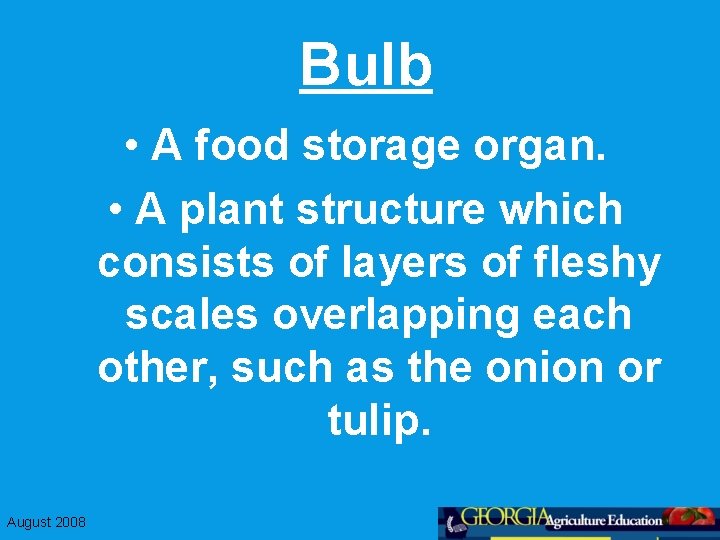
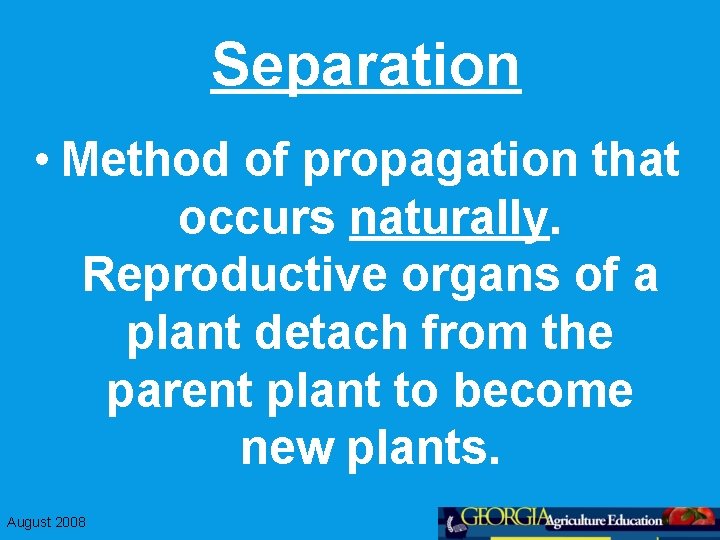
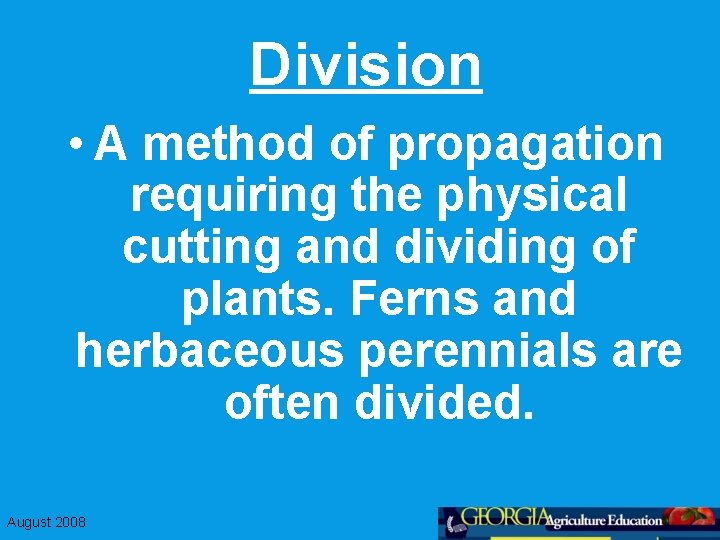
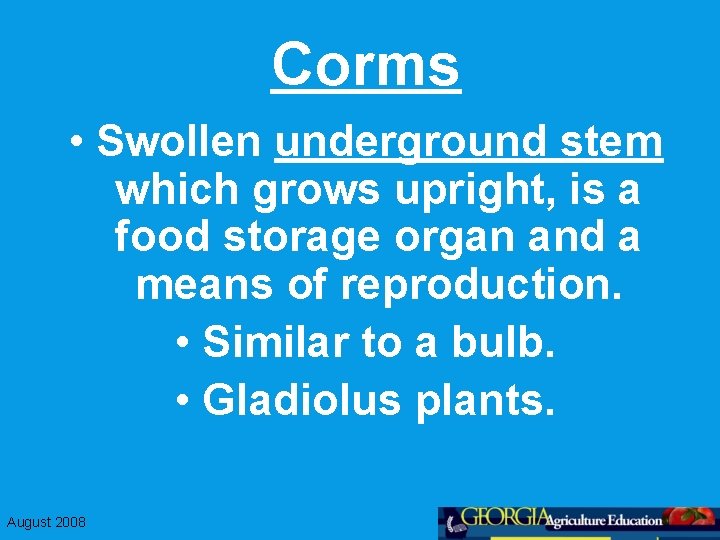
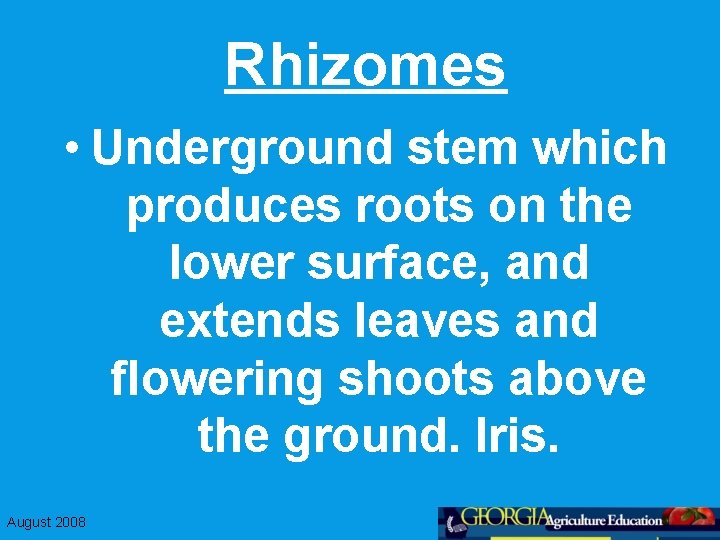
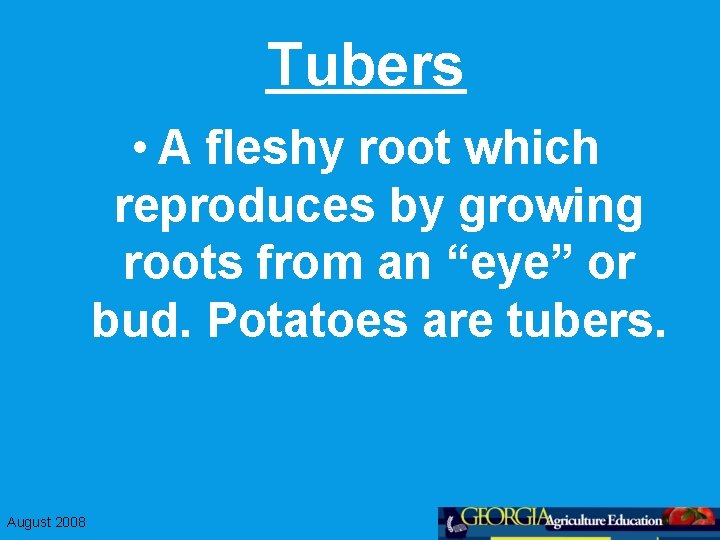
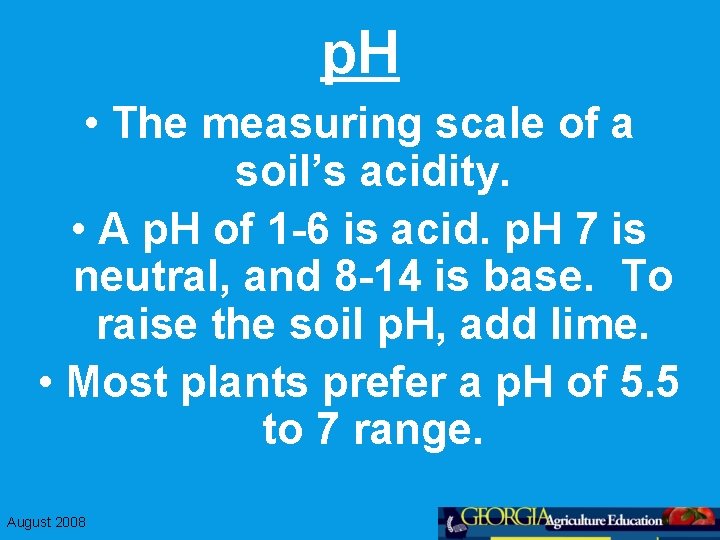
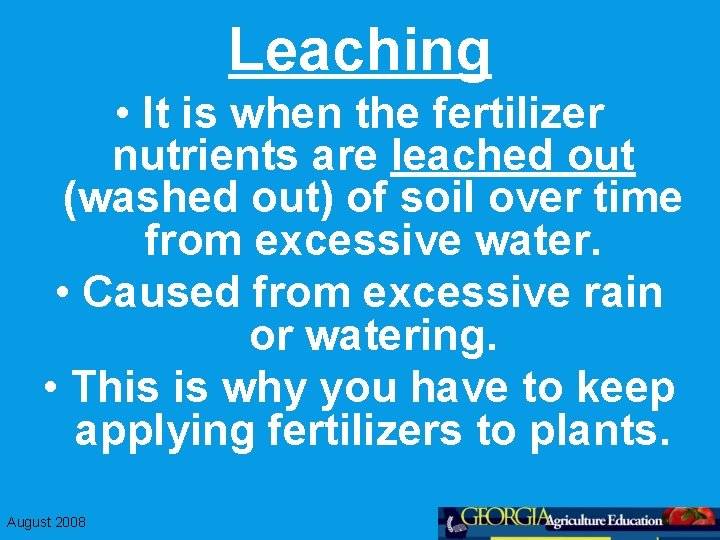
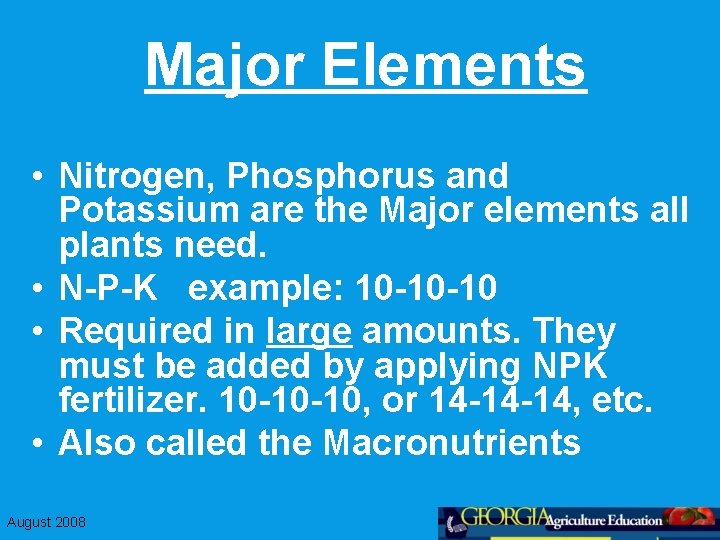
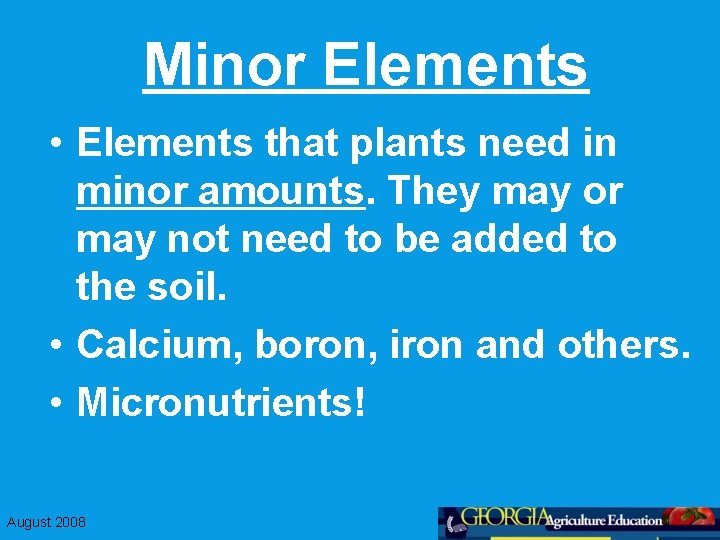
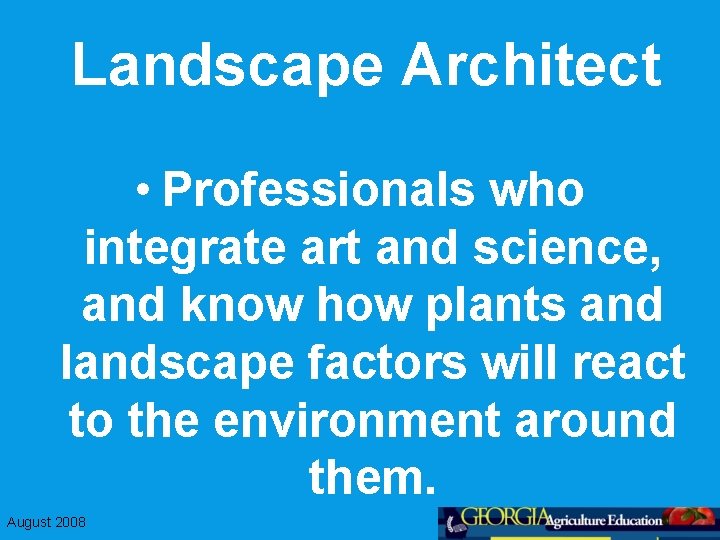


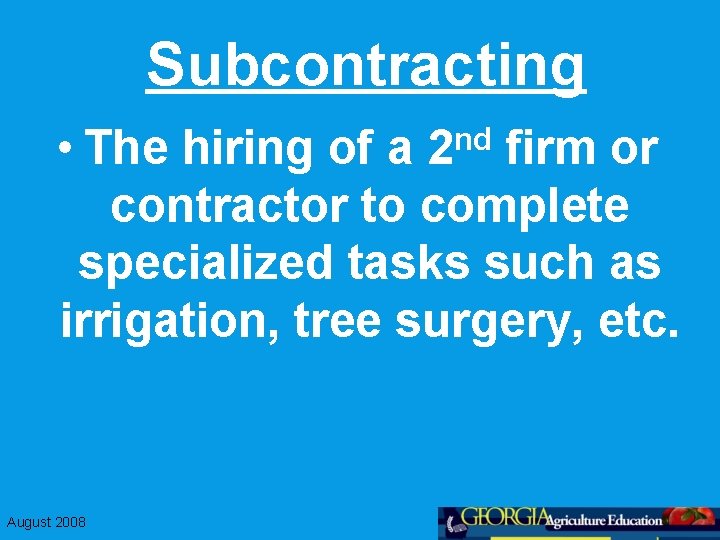

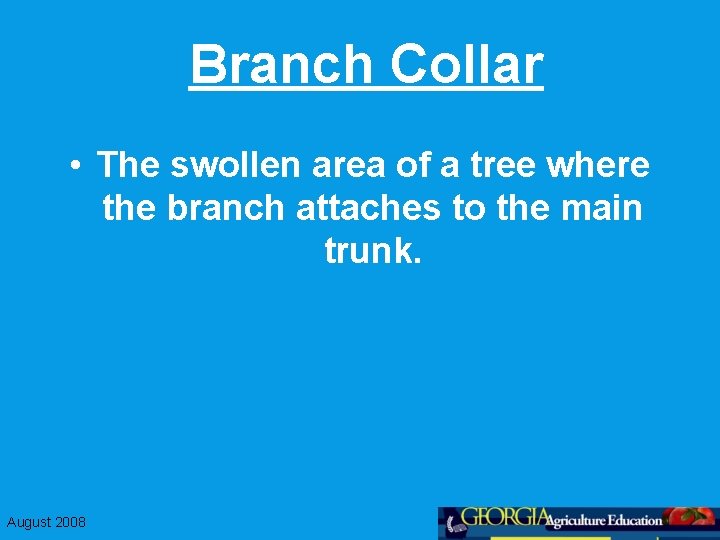
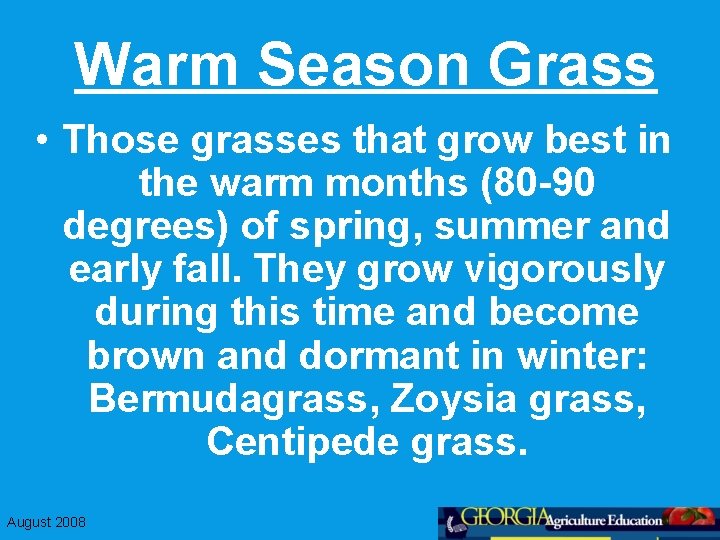
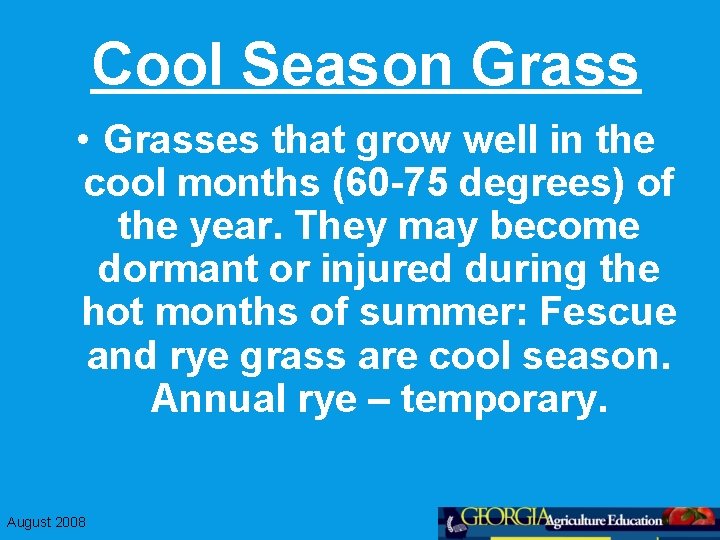
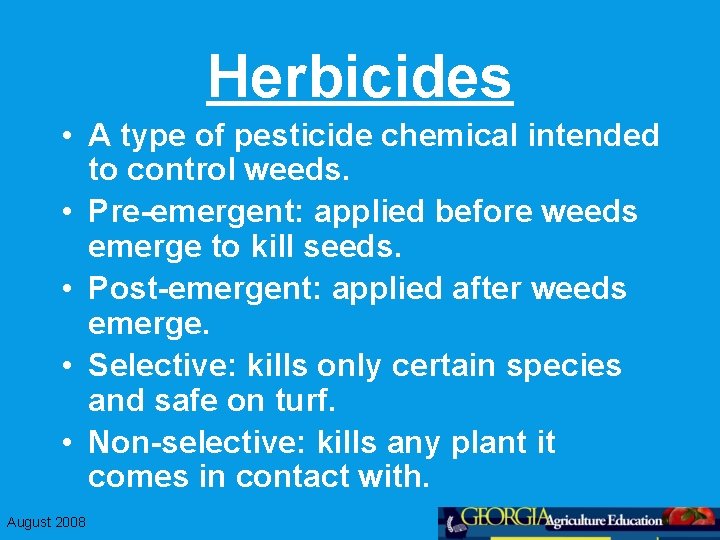
- Slides: 82

Horticulture Terms Pope High School Joe Green, Agriculture Teacher July 2005 August 2008

Horticulture • The ART of cultivating fruits, nuts, vegetables, or ornamental plants. • Horti = garden • Culture = garden culture August 2008

Floriculture • The cultivation of ornamental flowering plants. August 2008

Botany • The SCIENCE of plants to include anatomy, physiology and taxonomy. August 2008

Pomology • The science and practice of growing, harvesting and marketing tree fruits and nuts. Olericulture • The science and practice of growing, harvesting and marketing vegetables. August 2008

Annual • A plant which grows, flowers, produces seeds, and dies in one year. Must be replanted each year. Perennial • A plant that grows year after year without replanting. A plant whose roots lives year to year. August 2008

Taxonomy • The study of plant names and the identification of plants. Scientific name • The Latin name of a plant giving its genus and species. August 2008

Medium (Plural: Media) • Any material, which is used to start and grow, seeds and plants. August 2008

Seed coat • The outer covering of a seed. Endosperm • The stored food supply for the young developing seedling, which is contained in the seed. (“rocket fuel”) Embryo (embryonic plant) • The entire plant inside the seed before germination. August 2008

Hybrid • An offspring of two different varieties of one plant type, which possesses certain traits of each plant type. August 2008

Named varieties • Specific individual strains of one type of plant, which have been named to indicate their particular traits. August 2008

Cross Pollination • A process in which pollen (male sex cell) of one plant unites with the egg (female sex cell) of a different plant. Self Pollination • Fertilization of a plant by its own pollen. Male and female flower parts on the same flower. August 2008

Hardening Off Process • Gradually subjecting plants to more difficult growing conditions like withholding water and decreasing temperature, this prepares plants for transplanting by reducing transplant shock. August 2008

Cotyledons vs. True Leaves • Cotyledons are the first set of leaves that emerge from a seed at germination. • All other leaves are “true” leaves. • Cotyledons = “seed leaves” August 2008

Seed Germination • The miracle process when seeds begin to sprout and grow to begin a new plant • Germination occurs when a seed receives the correct amounts of light, temperature and water simultaneously. August 2008

Plant Propagation • The process of reproducing or increasing plants. Can be sexual or asexual. August 2008

Transpiration • Loss of water through the leaves or stems of plants. Sort of like “sweating” 90% of a plant’s water loss is here. • A normal daily process of plants. Higher water loss on sunny days. August 2008

Turgid • A plant whose tissues are swollen, filled with moisture. Not wilted. • Turgid plant = happy plant August 2008

Node • The “joint” of a stem, the swollen place where leaves and buds are attached. Roots form here when cuttings are made. Internode • The space between the nodes on a stem. August 2008

Callus • Mass of cells which forms around the wounded area of a plant to start the healing process. Similar to a “scab. ” New roots will form in this callus tissue. August 2008

Softwood Cutting • A cutting made from a stem whose tissue is softer and not as mature as the older wood. Hardwood Cutting • A cutting made from a current seasons stem tissue, which is mature or harder in texture. August 2008

Rooting Hormone • A plant chemical used to help new cuttings to form new roots faster. • Sort of like a “steroid” to enhance growth. August 2008

Tissue Culture • “micro-propagation” • The process of reproducing thousands of plants from a few cells taken from the terminal bud tissue of a plant. • “test tube plants” • Must have extremely sanitary laboratory conditions for tissue culture. August 2008

Root Division • The physical separation of roots to form new plants from one “mother” plant. Terminal Tip Growth • Softer tissue from the tip of the plant where most of the new growth occurs. August 2008

Binomial Nomenclature • The international naming system that gives every plant 2 names, genus and the specie in Latin. • Scientific Name = Botanic Name. August 2008

Linnaeus • The Swedish botanist that came up with the 2 name system for classifying plants. • 1750 August 2008

Genus • The first name of a plant scientific name. A group of plants that are grouped together because of their similarities to one another. (genera = plural). • A NOUN. Specie • The second name in scientific name, more specific in nature. • An ADJECTIVE that describes the genus. August 2008

Example: • Acer rubrum : Red Maple • Acer is the noun or genus. • rubrum is the adjective or specie that describes the genus (rubrum = red in latin) • Quercus alba = White Oak • Zebrina pendula, Setcresea purpurea August 2008

Cultivars • Another name for a specific plant, same as variety. • Example: There are several cultivars or “varieties”of Red Maple Tree. • “Red Sunset”, “October Glory” August 2008

Common Name • The local English name of a plant, which may differ in various localities. • Common names are not precise enough for commercial use. August 2008

Taxonomist • A person who studies plant names and the identification of plants as a career or field of study. August 2008

International Code of Botanical Nomenclature • A set of rules that are international for naming plants. August 2008

Mulch • Any material used to cover the soil for weed control and moisture retention. • Pine straw, pine bark nuggets, cypress shavings August 2008

Osmocote • A slow release fertilizer. Allows the plant to feed gradually over a longer period of time. Saves you labor. 14 -14 -14 August 2008

Herbaceous • Any plant that has soft tissue and does not form wood or bark. A non-woody plant. Houseplants, annuals & some perennials. Deciduous • A plant which loses its leaves each autumn. It goes dormant in the winter. August 2008

Evergreen • A plant which has leaves or needles throughout the whole year. August 2008

Petiole • The stalk structure which supports the blade of the leaf. It attaches the leaf blade to the stem. August 2008

Simple leaf • A solitary leaf attached to a stem by a petiole. Compound Leaf • A group of leaflets which compose the entire compound leaf. August 2008

Monocot • Classification of those plants having only one cotyledon or seed leaf. Grasses, chives and corn are monocots. • Parallel veins. Dicot • A classification of plants having two cotyledons or seed leaves. • Vascular or woody plants. August 2008

Leaf Margin • The outer edge of a leaf …. • Serrate, entire, lobed, etc. Root Cap • The actively growing cells at the tip of the plant root. August 2008

Stoma • Small pores or holes in the leaf, which allow the plant to breathe and give off moisture. They open and close with day and night. August 2008

Lenticels • Breathing pores in the bark of woody stems. They open and close with day and night. August 2008

Ventilation • Movement and exchange of air in a greenhouse. Photoperiodism • The response of plants to different periods of light and darkness in terms of their flowering. August 2008

Short Day Plant • A plant that blooms in the short winter days. • Some plants can be “tricked” into blooming by giving them short days artificially. Chrysanthemums and Poinsettias August 2008

Breaks • New shoots that develop as a result of “pinching”. • Same results as pruning out the terminal bud of a plant. August 2008

Growth Regulators • Chemicals that retard plant growth. It slows down the plant growth so they don’t get too tall and floppy. August 2008

Root Rot • Most common disease of Poinsettia. Caused by: Bad drainage, Bad ventilation or too much water. August 2008

Fungicide • Any substance which destroys or prevents the growth of fungi. • A type of pesticide to control plant diseases. August 2008

J. R. Poinsett • The U. S. Ambassador to Mexico who introduced the Poinsettia to America for future production. • Named the plant after himself. August 2008

Plant Hardiness • The ability of a plant withstand to the minimum temperature of an area. Plant Form • The outer shape of a tree and it’s branches. The outer silhouette. • Round, columnar, oval, weeping, etc. August 2008

Plant Texture • The size and thickness of the plant’s leaves and stems. Fine, Medium, Coarse. Bare Root Plants • Plants sold with no soil on the roots. A. Cheaper B. Very perishable August 2008

Balled and Burlapped • Plants- (B&B) Roots in burlap held together by twine. Dug up at a nursery and sold this way. Container Stock • Planted in a basket or plastic; or metal can. Can be planted at any time of the year. August 2008

Drip Line of a Tree • The imaginary line where water drops off from the farthest point of branches. August 2008

Narrow leaf Evergreen • Evergreen plants with needle-like or scaly foliage. Pines, Junipers. Broad leaf Evergreen • Evergreen plants with broad leaf blade. BLE Hollies and broad leaf plants. August 2008

Fascicles • The sheathes or bundles that contain needle like leaves attached to the branch in conifers. August 2008

Heeling in • The process of temporarily covering the plant roots when a tree has to be out of the ground for transplanting. The purpose is to retain the moisture around the roots with an organic material such as straw, mulch or soil during transplanting. August 2008

Berm • A ridge of soil placed around a newly planted tree to retain water. “a saucer” or “moat”. • Traps the water to stay on top of the root zone. August 2008

Ground Cover Plant • Any low growing plant, under 12” tall, that completely covers the ground. • Used in place of grass for large areas (saves labor of mowing) usually planted in mass. Creeping junipers, ivy, monkey grass, etc. Usually very durable plants. August 2008

Foundation Plantings • Plants which are used next to buildings to help accent and tie the buildings into the landscape. Usually evergreen. August 2008

Specimen Plant • A plant that is used alone for accent or focal point to a landscape. August 2008

Soil Conditioner • Organic matter added to the native soil to improve texture, drainage, and overall quality of the soil. Peat moss, pine bark, rotted compost etc. August 2008

Hard Pan • The unprepared or untilled soil line. Dense and hard section of soil. The roots cannot penetrate hard pan. August 2008

Boundary Plants • Plants used to separate property or boundary lines. Planted in rows. • Can be low or high depending on purpose. August 2008

Bulb • A food storage organ. • A plant structure which consists of layers of fleshy scales overlapping each other, such as the onion or tulip. August 2008

Separation • Method of propagation that occurs naturally. Reproductive organs of a plant detach from the parent plant to become new plants. August 2008

Division • A method of propagation requiring the physical cutting and dividing of plants. Ferns and herbaceous perennials are often divided. August 2008

Corms • Swollen underground stem which grows upright, is a food storage organ and a means of reproduction. • Similar to a bulb. • Gladiolus plants. August 2008

Rhizomes • Underground stem which produces roots on the lower surface, and extends leaves and flowering shoots above the ground. Iris. August 2008

Tubers • A fleshy root which reproduces by growing roots from an “eye” or bud. Potatoes are tubers. August 2008

p. H • The measuring scale of a soil’s acidity. • A p. H of 1 -6 is acid. p. H 7 is neutral, and 8 -14 is base. To raise the soil p. H, add lime. • Most plants prefer a p. H of 5. 5 to 7 range. August 2008

Leaching • It is when the fertilizer nutrients are leached out (washed out) of soil over time from excessive water. • Caused from excessive rain or watering. • This is why you have to keep applying fertilizers to plants. August 2008

Major Elements • Nitrogen, Phosphorus and Potassium are the Major elements all plants need. • N-P-K example: 10 -10 -10 • Required in large amounts. They must be added by applying NPK fertilizer. 10 -10 -10, or 14 -14 -14, etc. • Also called the Macronutrients August 2008

Minor Elements • Elements that plants need in minor amounts. They may or may not need to be added to the soil. • Calcium, boron, iron and others. • Micronutrients! August 2008

Landscape Architect • Professionals who integrate art and science, and know how plants and landscape factors will react to the environment around them. August 2008

Landscape Contractor • A company or person who deals primarily with the installation of landscapes. They install what the architect designs. August 2008

Landscape Maintenance Contractor • A firm that maintains the landscape under the guidelines of a contract. weekly/monthly. August 2008

Subcontracting • The hiring of a firm or contractor to complete specialized tasks such as irrigation, tree surgery, etc. nd 2 August 2008

Site Analysis • Making an evaluation of the landscape site to determine how many of the clients needs can be met. It tells what is present on the site and what is desired. August 2008

Branch Collar • The swollen area of a tree where the branch attaches to the main trunk. August 2008

Warm Season Grass • Those grasses that grow best in the warm months (80 -90 degrees) of spring, summer and early fall. They grow vigorously during this time and become brown and dormant in winter: Bermudagrass, Zoysia grass, Centipede grass. August 2008

Cool Season Grass • Grasses that grow well in the cool months (60 -75 degrees) of the year. They may become dormant or injured during the hot months of summer: Fescue and rye grass are cool season. Annual rye – temporary. August 2008

Herbicides • A type of pesticide chemical intended to control weeds. • Pre-emergent: applied before weeds emerge to kill seeds. • Post-emergent: applied after weeds emerge. • Selective: kills only certain species and safe on turf. • Non-selective: kills any plant it comes in contact with. August 2008
 Pope hs band
Pope hs band Foraging horticulture agriculture pastoralism
Foraging horticulture agriculture pastoralism Show me green
Show me green Sekeepare
Sekeepare Agriculture terms
Agriculture terms Green hope high school mascot
Green hope high school mascot Polynomial classification
Polynomial classification What are like terms
What are like terms What is leisa
What is leisa Joe baca middle school calendar
Joe baca middle school calendar Crescenta valley high school graduation 2021
Crescenta valley high school graduation 2021 Assignment in spanish
Assignment in spanish Lernpyramide von green & green (2005)
Lernpyramide von green & green (2005) Blue green yellow red
Blue green yellow red Frc driver station mac
Frc driver station mac Vicarius filidei
Vicarius filidei Dep horticulture
Dep horticulture Importance of horticulture
Importance of horticulture Clarissa's speech canto 5
Clarissa's speech canto 5 Importance of pomology
Importance of pomology Alexander pope sound and sense
Alexander pope sound and sense Word painting in fair phyllis
Word painting in fair phyllis Giuseppe roncalli
Giuseppe roncalli Pope dioscorus i of alexandria
Pope dioscorus i of alexandria Pope hilarious
Pope hilarious Cpwd sor
Cpwd sor Ornamental horticulture demonstrations ideas
Ornamental horticulture demonstrations ideas List of horticulture careers
List of horticulture careers Horticulture buyer jobs
Horticulture buyer jobs Horticulture word
Horticulture word Horticulture history
Horticulture history Hq of international society for horticultural science is at
Hq of international society for horticultural science is at International society of horticulture science
International society of horticulture science Importance of horticulture
Importance of horticulture Horticulture climate control
Horticulture climate control Pope kyrillos vi
Pope kyrillos vi Dsr 2018 civil
Dsr 2018 civil Vicky pope
Vicky pope Importance of horticulture
Importance of horticulture Roger pope education
Roger pope education Motet definition
Motet definition Pope globalization academy
Pope globalization academy Kitty pope
Kitty pope What is division in horticulture
What is division in horticulture Where did horticulture begin
Where did horticulture begin Motto of pope francis
Motto of pope francis Pope francis evangelii gaudium quotes
Pope francis evangelii gaudium quotes Urban horticulture
Urban horticulture The power of the church chapter 13 section 4
The power of the church chapter 13 section 4 Causes of otto invades italy on pope's behalf
Causes of otto invades italy on pope's behalf Horticulture
Horticulture Pope marcellus mass gloria palestrina
Pope marcellus mass gloria palestrina Pope pius award
Pope pius award Pope francis
Pope francis Pope francis global academy
Pope francis global academy Whos for the game jessie pope
Whos for the game jessie pope Medicinal plants definition
Medicinal plants definition Pope gregory iii
Pope gregory iii Darlene pope
Darlene pope Pope demetrius i of alexandria
Pope demetrius i of alexandria Chapter 4 the horticulture industry
Chapter 4 the horticulture industry Introduction of the rape of the lock
Introduction of the rape of the lock Pope jr basketball
Pope jr basketball Tomb of pope julius ii
Tomb of pope julius ii Horticulture
Horticulture Pope francis is catholic
Pope francis is catholic Pope eye care camden ar
Pope eye care camden ar Ad altare dei answers chapter 1
Ad altare dei answers chapter 1 Pueblo revolt apush
Pueblo revolt apush Growing plants
Growing plants Pope paul iv
Pope paul iv Epistrophe
Epistrophe Bethany lynn stephens
Bethany lynn stephens What ishorticulture
What ishorticulture Horticulture branches
Horticulture branches What is horticulture
What is horticulture Paschal mystery quotes
Paschal mystery quotes Jeannie crowley
Jeannie crowley Introduction to horticulture
Introduction to horticulture Undernourished parents often raise
Undernourished parents often raise Culinary terms
Culinary terms High precision vs high recall
High precision vs high recall High precision vs high recall
High precision vs high recall

